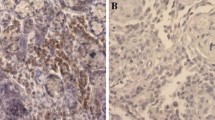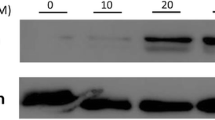Abstract
Purpose
To identify the proteins involved in radioresistance in nasopharyngeal cancer (NPC) cells.
Methods
Sublethal ionizing radiation was applied to establish a radioresistant NPC cell line from its parental NPC cell line CNE1. Clonogenic survival assay, cell growth assay and flow cytometry analysis were used to examine the difference of radiosensitivity in the radioresistant CNE1 cells (CNE1-IR) and control CNE1 cells. Comparative proteomics was performed to identify the differential proteins in the two cell lines. Association of HSP27, one of upregulated proteins in CNE1-IR cells, with NPC cell radioresistance was selected for further investigation using antisense oligonucleotides (ASOs), clonogenic survival assay, Hoechst 33258 staining of apoptotic cells and MTT assay of cell viability.
Results
Radioresistant NPC cell line CNE1-IR derived from its parental cell line CNE1 was established. Thirteen differential proteins in the CNE1-IR and CNE1 cells were identified by proteomics, and differential expression of HSP27, one of identified proteins, was selectively confirmed by western blot. Inhibition of HSP27 expression by HSP27 ASOs decreased clonogenic survival and cell viability and increased cell apoptosis of CNE1-IR cells after irradiation, that is, enhanced radiosensitivity of CNE1-IR cells.
Conclusion
The data suggest that HSP27 is a radioresistant protein in NPC cells, and its upregulation may be involved in the NPC radioresistance.




Similar content being viewed by others
References
Avanzo M, Stancanello J, Franchin G, Sartor G, Jena R, Drigo A et al (2010) Correlation of a hypoxia based tumor control model with observed local control rates in nasopharyngeal carcinoma treated with chemoradiotherapy. Med Phys 37:1533–1544
Bruey JM, Ducasse C, Bonniaud P, Ravagnan L, Susin SA, Diaz-Latoud C et al (2000) Hsp27 negatively regulates cell death by interacting with cytochrome c. Nat Cell Biol 2:645–652
Calderwood SK, Khaleque MA, Sawyer DB, Ciocca DR (2006) Heat shock proteins in cancer: chaperones of tumorigenesis. Trends Biochem Sci 31:164–172
Caponigro F, Longo F, Ionna F, Perri F (2010) Treatment approaches to nasopharyngeal carcinoma: a review. Anticancer Drugs 21:471–477
Chang JT, Chan SH, Lin CY, Lin TY, Wang HM, Liao CT et al (2007) Differentially expressed genes in radioresistant nasopharyngeal cancer cells: gp96 and GDF15. Mol Cancer Ther 6:2271–2279
Choi SH, Lee YJ, Seo WD, Lee HJ, Nam JW, Lee YJ et al (2011) Altered cross-linking of HSP27 by zerumbone as a novel strategy for overcoming HSP27-mediated radioresistance. Int J Radiat Oncol Biol Phys 79:1196–1205
Ciocca DR, Calderwood SK (2005) Heat shock proteins in cancer: diagnostic, prognostic, predictive, and treatment implications. Cell Stress Chaperones 10:86–103
Ciocca DR, Oesterreich S, Chamness GC, McGuire WL, Fuqua SA (1993) Biological and clinical implications of heat shock protein 27,000 (Hsp27): a review. J Natl Cancer Inst 85:558–1570
Ehrnsperger M, Gräber S, Gaestel M, Buchner J (1997) Binding of non-native protein to Hsp25 during heat shock creates a reservoir of folding intermediates for reactivation. EMBO J 16:221–229
Ekedahl J, Joseph B, Marchetti P, Fauvel H, Formstecher P, Lewensohn R et al (2003) Heat shock protein 72 does not modulate ionizing radiation-induced apoptosis in U1810 non-small cell lung carcinoma cells. Cancer Biol Ther 2:663–669
Feng XP, Yi H, Li MY, Li XH, Yi B, Zhang PF et al (2010) Identification of biomarkers for predicting nasopharyngeal carcinoma response to radiotherapy by proteomics. Cancer Res 70:3450–3462
Fortin A, Raybaud-Diogène H, Têtu B, Deschenes R, Huot J, Landry J (2000) Overexpression of the 27 kDa heat shock protein is associated with thermoresistance and chemoresistance but not with radioresistance. Int J Radiat Oncol Biol Phys 46:1259–1266
Garrido C, Gurbuxani S, Ravagnan L, Kroemer G (2001) Heat shock proteins: endogenous modulators of apoptotic cell death. Biochem Biophys Res Commun 286:433–442
Gudkov AV, Komarova EA (2003) The role of p53 in determining sensitivity to radiotherapy. Nat Rev Cancer 3:117–129
Jayasurya A, Bay BH, Yap WM, Tan NG (2000) Correlation of metallothionein expression with apoptosis in nasopharyngeal carcinoma. Br J Cancer 82:1198–1203
Konishi H, Matsuzaki H, Tanaka M, Takemura Y, Kuroda S, Ono Y et al (1997) Activation of protein kinase B (Akt/RAC-protein kinase) by cellular stress and its association with heat shock protein Hsp27. FEBS Lett 410:493–498
Kristensen CA, Kjaer-Kristoffersen F, Sapru W, Berthelsen AK, Loft A, Specht L (2007) Nasopharyngeal carcinoma. Treatment planning with IMRT and 3D conformal radiotherapy. Acta Oncol 46:214–220
Lee AW, Poon YF, Foo W, Law SC, Cheung FK, Chan DK, Tung SY (1992) Retrospective analysis of 5037 patients with nasopharyngeal carcinoma treated during 1976–1985: overall survival and patterns of failure. Int J Radiat Oncol Biol Phys 23:261–270
Lee AW, Tung SY, Chua DT, Ngan RK, Chappell R, Tung R et al (2010) Randomized trial of radiotherapy plus concurrent-adjuvant chemotherapy vs radiotherapy alone for regionally advanced nasopharyngeal carcinoma. J Natl Cancer Inst 102:1188–1198
Lee HJ, Kim EH, Seo WD, Choi TH, Cheon GJ, Lee YJ et al (2011) Heat shock protein 27-targeted heptapeptide of the PKCDelta catalytic V5 region sensitizes tumors with radio- and chemoresistance. Int J Radiat Oncol Biol Phys 80:221–230
Leung SF, Teo PM, Shiu WW, Tsao SY, Leung TW (1991) Clinical features and management of distant metastases of nasopharyngeal carcinoma. J Otolaryngol 20:27–29
Liu XF, Xia YF, Li MZ, Wang HM, He YX, Zheng ML et al (2006) The effect of p21 antisense oligodeoxynucleotides on the radiosensitivity of nasopharyngeal carcinoma cells with normal p53 function. Cell Biol Int 30:283–287
Lu ZX, Ma XQ, Yang LF, Wang ZL, Zeng L, Li ZJ et al (2008) DNAzymes targeted to EBV-encoded latent membrane protein-1 induce apoptosis and enhance radiosensitivity in nasopharyngeal carcinoma. Cancer Lett 265:226–238
Ma X, Yang L, Xiao L, Tang M, Liu L, Li Z et al (2011) Down-regulation of EBV-LMP1 radio-sensitizes nasopharyngeal carcinoma cells via NF-κB regulated ATM expression. PLoS One 6:e24647
Maliutina IaV, Kabakov AE (2007) Pre irradiation heat shock protein induction increases cellular radioresistance. Radiats Biol Radioecol 47:273–279
Mehlen P, Kretz-Remy C, Preville X, Arrigo AP (1996) Human hsp27, Drosophila hsp27 and human alphaB-crystallin expression-mediated increase in glutathione is essential for the protective activity of these proteins against TNFalpha-induced cell death. EMBO J 15:2695–2706
Ong YK, Solares CA, Lee S, Snyderman CH, Fernandez-Miranda J, Gardner PA (2011) Endoscopic nasopharyngectomy and its role in managing locally recurrent nasopharyngeal carcinoma. Otolaryngol Clin North Am 44:1141–1154
Rocchi P, So A, Kojima S, Signaevsky M, Beraldi E, Fazli L et al (2004) Heat shock protein 27 increases after androgen ablation and plays a cytoprotective role in hormone-refractory prostate cancer. Cancer Res 64:6595–6602
Teo P, Yu P, Lee WY, Leung SF, Kwan WH, Yu KH et al (1996) Significant prognosticators after primary radiotherapy in 903 non disseminated nasopharyngeal carcinoma evaluated by computer tomography. Int J Radiat Oncol Biol Phys 36:291–304
Trautinger F, Kokesch C, Herbacek I, Knobler RM, Kindas-Mugge I (1997) Overexpression of the small heat shock protein, hsp27, confers resistance to hyperthermia, but not to oxidative stress and UV-induced cell death, in a stably transfected squamous cell carcinoma cell line. J Photochem Photobiol, B 39:90–95
Wano C, Kita K, Takahashi S, Sugaya S, Hino M, Hosoya H et al (2004) Protective role of HSP27 against UVC-induced cell death in human cells. Exp Cell Res 298:584–592
Yang YX, Xiao ZQ, Chen ZC, Zhang GY, Yi H, Zhang PF et al (2006) Proteome analysis of multidrug resistance in vincristine-resistant human gastric cancer cell line SGC7901/VCR. Proteomics 6:2009–2021
Yang S, Wu J, Zuo Y, Tan L, Jia H, Yan H et al (2010) ZD6474, a small molecule tyrosine kinase inhibitor, potentiates the anti-tumor and anti-metastasis effects of radiation for human nasopharyngeal carcinoma. Curr Cancer Drug Targets 10:611–622
Zhang Z, Zhu W, Zhang J, Guo L (2011) Tyrosine kinase Etk/BMX protects nasopharyngeal carcinoma cells from apoptosis induced by radiation. Cancer Biol Ther 11:690–698
Zhou BB, Elledge SJ (2000) The DNA damage response: putting checkpoints in perspective. Nature 408:433–439
Zhuang H, Jiang W, Cheng W, Qian K, Dong W, Cao L et al (2010) Down-regulation of HSP27 sensitizes TRAIL-resistant tumor cell to TRAIL-induced apoptosis. Lung Cancer 68:27–38
Acknowledgments
This work was supported by National Nature Science Foundation of China (30973290, 81172559, 81172302), Lotus Scholars Program of Hunan Province, China (2007-362), Key Research Program from Science and Technology Department of Hunan Province, China (2010FJ2009), Nature Science Foundation of Hunan Province, China (11JJ2045).
Conflict of interest
None.
Author information
Authors and Affiliations
Corresponding authors
Rights and permissions
About this article
Cite this article
Zhang, B., Qu, JQ., Xiao, L. et al. Identification of heat shock protein 27 as a radioresistance-related protein in nasopharyngeal carcinoma cells. J Cancer Res Clin Oncol 138, 2117–2125 (2012). https://doi.org/10.1007/s00432-012-1293-0
Received:
Accepted:
Published:
Issue Date:
DOI: https://doi.org/10.1007/s00432-012-1293-0




